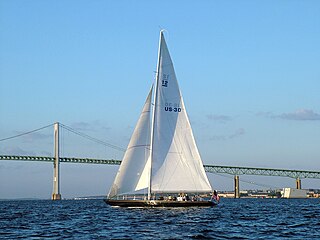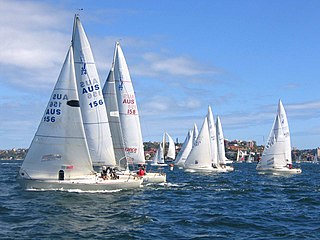
The America's Cup, informally known as the Auld Mug, is a trophy awarded in the sport of sailing. It is the oldest international competition still operating in any sport. America's Cup match races are held between two sailing yachts: one from the yacht club that currently holds the trophy and the other from the yacht club that is challenging for the cup. There is no fixed schedule, with matches held several years apart on dates agreed between the defender and the challenger. The most recent America's Cup match took place in March 2021.

Oracle Team USA is an American yacht racing syndicate initially formed to compete for the 2003 America's Cup. They competed again in the 2007 event before winning the 33rd America's Cup regatta in 2010 – representing the Golden Gate Yacht Club. The team also won the 34th America's Cup in 2013.

The International Americas Cup Class is a class of racing yacht that was developed for the America's Cup between 1992 and 2007. These yachts, while not identical, were all designed to the same formula to offer designers the freedom to experiment whilst keeping the boats sufficiently comparable to race in real time. The class was established for the 1992 America's Cup because of perceived shortcomings of the 12-metre class, which had been used in the America's Cup since 1958.
One-Design is a racing method which may be adopted in sports which use complex equipment, whereby all vehicles have identical or very similar designs or models.

The 12 Metre class is a rating class for racing sailboats that are designed to the International rule. It enables fair competition between boats that rate in the class whilst retaining the freedom to experiment with the details of their designs. The designation "12 Metre" does not refer to any single measurement on the boat, and is not referencing the vessels overall length, rather, measures the sum of the components directed by the formula which governs design and construction parameters. Typically 12 Metre class boats range from 65 to 75 feet in length overall; they are most often sloop-rigged, with masts roughly 85 feet tall.

A J-Class yacht is a single-masted racing yacht built to the specifications of Nathanael Herreshoff's Universal Rule. The J-Class are considered the peak racers of the era when the Universal Rule determined eligibility in the America's Cup.

The International rule, also known as the Metre rule, was created for the measuring and rating of yachts to allow different designs of yacht to race together under a handicap system. Prior to the ratification of the International rule in 1907, countries raced yachts under their own national rules and international competition was always subject to various forms of subjective handicapping.

The A-Class Catamaran, often abbreviated to A-Cat, is a development class sailing catamaran for singlehanded racing.

The Formula 18 class, abbreviated F18, is a non-foiling, restricted development, formula-design sport catamaran class. It was started in the early 1990s and quickly grew getting class recognition by World Sailing, with large racing fleets all over the globe.

The Formula 16 (F16) sport catamaran is an ISAF recognised 5 m long beach catamaran with an asymmetric spinnaker setup.
The International Catamaran Challenge Trophy is the formal name for the match racing series between two catamarans familiarly known the Little Americas Cup. While a championship series sailed between C Class catamarans does still exist, it is no longer known as the Little America's Cup.

A sailing hydrofoil, hydrofoil sailboat, or hydrosail is a sailboat with wing-like foils mounted under the hull. As the craft increases its speed the hydrofoils lift the hull up and out of the water, greatly reducing wetted area, resulting in decreased drag and increased speed. A sailing hydrofoil can achieve speeds exceeding twice the wind speed.
Luna Rossa Prada Pirelli, originally named Prada Challenge, then Luna Rossa Challenge, is an Italian sailboat racing syndicate first created to compete for the 2000 America's Cup. It won the Louis Vuitton Cup on their first attempt in 2000, but then lost the America's Cup match against the defending champion team, Team New Zealand.

High-performance sailing is achieved with low forward surface resistance—encountered by catamarans, sailing hydrofoils, iceboats or land sailing craft—as the sailing craft obtains motive power with its sails or aerofoils at speeds that are often faster than the wind on both upwind and downwind points of sail. Faster-than-the-wind sailing means that the apparent wind angle experienced on the moving craft is always ahead of the sail. This has generated a new concept of sailing, called "apparent wind sailing", which entails a new skill set for its practitioners, including tacking on downwind points of sail.
Ton classes are categories used to identify classes of yachts.

The sport of sailing involves a variety of competitive sailing formats that are sanctioned through various sailing federations and yacht clubs. Racing disciplines include matches within a fleet of sailing craft, between a pair thereof or among teams. Additionally, there are specialized competitions that include setting speed records. Racing formats include both closed courses and point-to-point contests; they may be in sheltered waters, coast-wise or on the open ocean. Most competitions are held within defined classes or ratings that either entail one type of sailing craft to ensure a contest primarily of skill or rating the sailing craft to create classifications or handicaps.

The AC72 is a class of wingsail catamarans built to a box rule, which governs the construction and operation of yachts competing in the 2013 Louis Vuitton and the America's Cup races. The class was subsequently replaced by the smaller AC50 class.

The International B-class/F20 Catamaran, is a development class, on the comeback after the fracturing of the original B-class, into the myriad of one design, off the beach cats we have today.

The AC50 was a wingsail catamaran development rule that governed the construction of the yachts used in the 2017 Louis Vuitton Cup and the 2017 America's Cup. Like the larger AC72s used in the 2013 America's Cup, AC50s used L-shaped daggerboard stabilizers as well as T-shaped rudder elevators that were able to generate enough lift to allow the boats to exit displacement mode in winds in excess of 7kt. Prototype versions of crossbeams, wingsails, appendages, as well as steering and trimming systems had been tested by all syndicates on AC45 platforms as surrogate yachts before building their AC50. The class allowed hydraulic control of the wingsails and appendages. Motors and computer automation was banned in the class. Each challenger team was only allowed to build one AC50 for competition and only six boats were built.

The America's Cup World Series are match races and fleet regattas used as heats for the 2013 America's Cup and the 2017 America's Cup.















